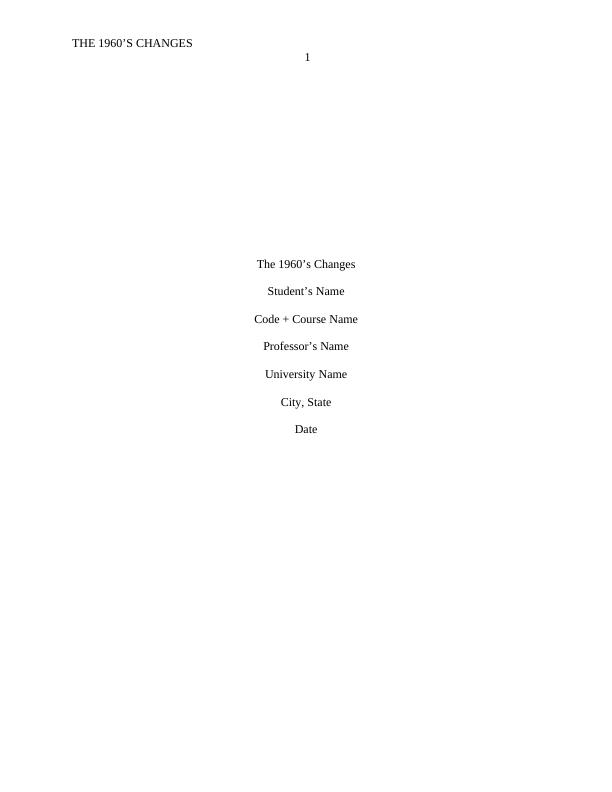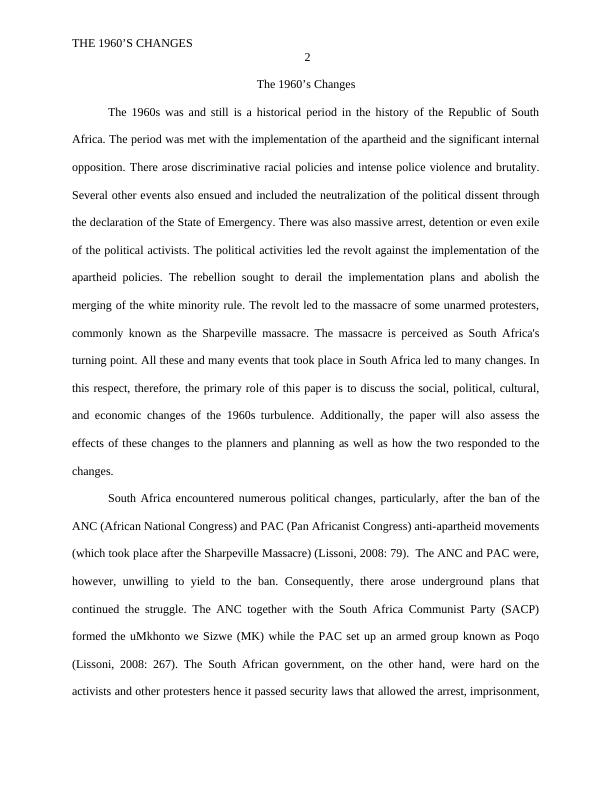Paper Discussing on Changes after 1960s Turbulence
Added on 2020-02-19
6 Pages1568 Words34 Views
THE 1960’S CHANGES 1The 1960’s ChangesStudent’s NameCode + Course NameProfessor’s NameUniversity NameCity, StateDate

THE 1960’S CHANGES2The 1960’s ChangesThe 1960s was and still is a historical period in the history of the Republic of SouthAfrica. The period was met with the implementation of the apartheid and the significant internalopposition. There arose discriminative racial policies and intense police violence and brutality.Several other events also ensued and included the neutralization of the political dissent throughthe declaration of the State of Emergency. There was also massive arrest, detention or even exileof the political activists. The political activities led the revolt against the implementation of theapartheid policies. The rebellion sought to derail the implementation plans and abolish themerging of the white minority rule. The revolt led to the massacre of some unarmed protesters,commonly known as the Sharpeville massacre. The massacre is perceived as South Africa'sturning point. All these and many events that took place in South Africa led to many changes. Inthis respect, therefore, the primary role of this paper is to discuss the social, political, cultural,and economic changes of the 1960s turbulence. Additionally, the paper will also assess theeffects of these changes to the planners and planning as well as how the two responded to thechanges. South Africa encountered numerous political changes, particularly, after the ban of theANC (African National Congress) and PAC (Pan Africanist Congress) anti-apartheid movements(which took place after the Sharpeville Massacre) (Lissoni, 2008: 79). The ANC and PAC were,however, unwilling to yield to the ban. Consequently, there arose underground plans thatcontinued the struggle. The ANC together with the South Africa Communist Party (SACP)formed the uMkhonto we Sizwe (MK) while the PAC set up an armed group known as Poqo(Lissoni, 2008: 267). The South African government, on the other hand, were hard on theactivists and other protesters hence it passed security laws that allowed the arrest, imprisonment,

THE 1960’S CHANGES3and detention of the activities. The political pressure from the government was overwhelming tothe movement a factor that led some activities to go to exile. However, while in exile the SACP,PAC, and ANC established military training bases, camps, and offices (Lissoni, 2008: 44). Later,what ensued was the spread of the Anti Apartheid Movement to Holland, Sweden, Britain, andseveral other countries (Lissoni, 2008: 49). The formation of the liberation movements meantmore pressure on the South African Government hence its inability to abolish apartheid. The 1960's apartheid had adverse effects on the economic growth of South Africa. The economic productivity and profitability in the country were primarily affected by the importsubstitution strategy (Bhattacharya and Lowenberg: 41). Moreover, the investors recorded lowerprofits and return on investment due to the discriminative labour. Essentially, investors and othersavers were unwilling to invest in long term projects thereby reducing the investment rate inphysical capital (Marais, 2013: 53). Similarly, the education policies of 1960 are led to minimalhuman capital investment particularly on black workforce (Bhattacharya and Lowenberg: 40).Therefore, there was no equilibrium between the human and the physical capital. Additionally, South Africa experienced both social and cultural segregation. Segregationpermeated every aspect of life including schools, transport, trading, settlements, work places,public social places (beaches, theatres, and beaches), and churches (Clark and Worger: 36).Evidently, the whites and the non-whites were not permitted to socialize, relate or mixwhatsoever. Blacks, therefore, were unequal to whites. The latter was treated with respect andprestige (Walker, 2000: 263). Moreover, there was an Act that prohibited mixed marriagesbetween the whites and the people of colour (Clark and Worger: 40). Another Act, the GroupAreas Act (1950) divided the country into different areas which were later occupied by various

End of preview
Want to access all the pages? Upload your documents or become a member.
